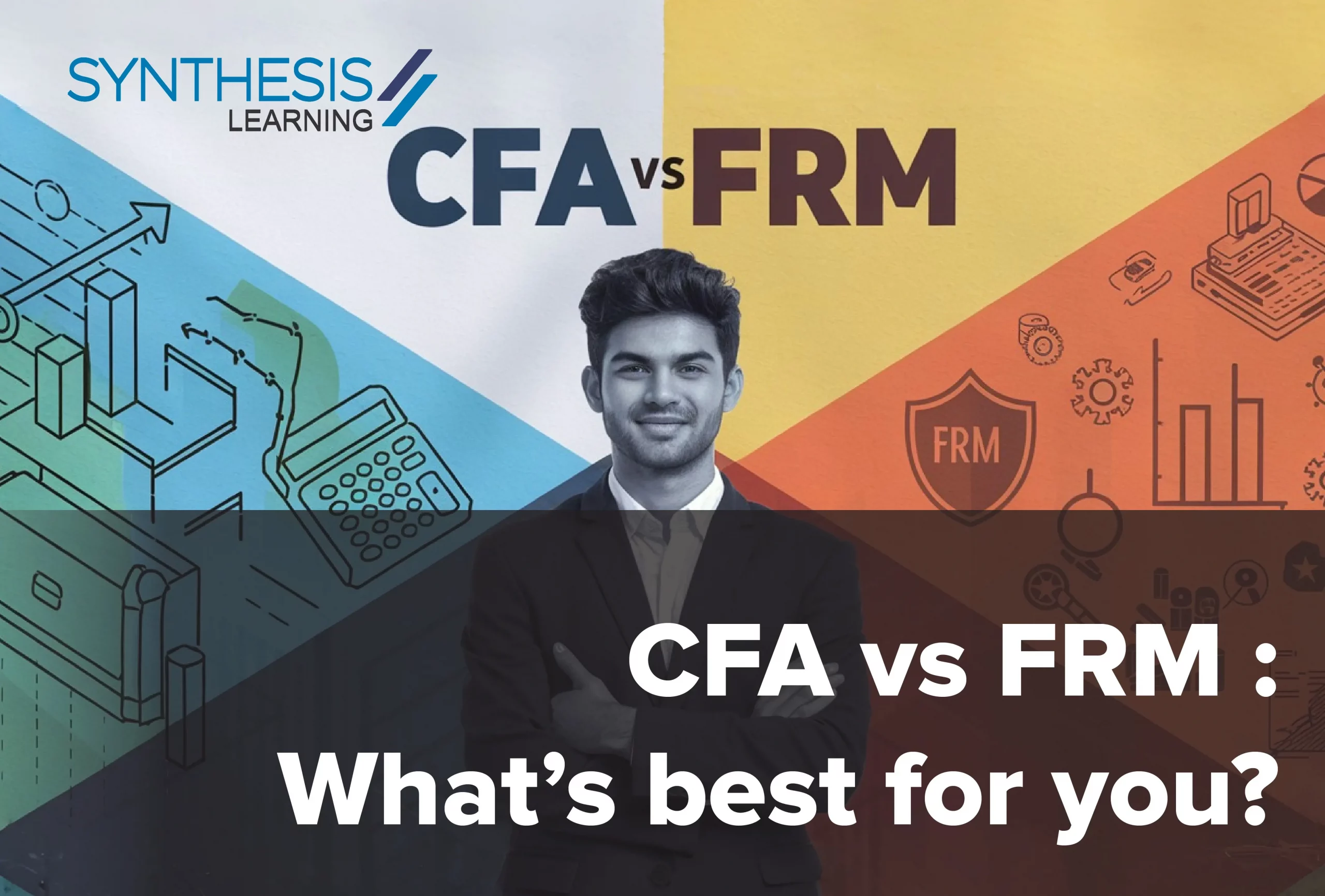CFA vs FRM
What’s best for you?
The Chartered Financial Analyst (CFA) and Financial Risk Manager (FRM) qualifications are two of the most prestigious financial industry qualifications, each catering to distinct career paths. The CFA program, offered by the CFA Institute, is ideal for those aiming for investment management, portfolio strategy, and financial advisory roles, with a broad curriculum covering ethics, economics, and investment analysis. On the other hand, the FRM certification, administered by GARP, is tailored for professionals focused on risk management, offering specialised knowledge in areas like market risk, credit risk, and operational risk.
While the CFA requires a longer time commitment (2–3 years) and has a broader scope, the FRM is shorter (1–1.5 years) and more niche, making it suitable for those passionate about risk analysis and mitigation. Both qualifications offer excellent career opportunities and ROI, but the choice depends on your career aspirations—CFA for investment-focused roles and FRM for risk management.
CFA vs FRM
When embarking on a career in finance, two globally recognized qualifications stand out: CFA (Chartered Financial Analyst) and FRM (Financial Risk Manager). Both offer exceptional career potential but are tailored to distinct niches within the financial sector. If you’re debating between CFA and FRM, this guide will help you discern their differences, and similarities, and determine the path best aligned with your aspirations.
Table Of Contents
What’s best for you?
Understanding CFA and FRM
Subjects Covered
Focus on Ethics
CFA vs FRM – Eligibility Criteria
CFA vs FRM – Program Structure and Duration
CFA vs FRM – Passing Percentages
Exam Format and Difficulty
Exam Scheduling and Flexibility
Study Material and Preparation Time
CFA vs FRM – Career Opportunities
Cost to be Paid to the Respective Institute
Salary Comparisons
CFA Work Experience:
Combining CFA and FRM
Global Recognition and Employer Preferences
Which One Should You Choose?
Which Certification is Right for You?
Conclusion: Which Should You Choose?
FAQs
5 Common CFA Myths Busted: Watch This Eye-Opening Video!
Understanding CFA and FRM
CFA (Chartered Financial Analyst)
– Offered by the CFA Institute (USA), the CFA charter is regarded as the gold standard for investment professionals.
– Provides comprehensive insights into wealth management, portfolio strategies, and investment principles.
– Best suited for individuals aspiring to roles such as equity research, portfolio management, or financial advisory.
FRM (Financial Risk Manager)
– Administered by the Global Association of Risk Professionals (GARP).
– Focuses on financial risk management, including risk assessment and mitigation.
– Ideal for careers in banking, insurance, and other risk-intensive sectors.
Subjects Covered
CFA Curriculum
Ethical and Professional Standards
Quantitative Methods
Economics
Financial Reporting and Analysis
Corporate Finance
Equity Investments
Fixed Income
Derivatives
Alternative Investments
Portfolio Management, Private Wealth and Private Markets
Curriculum
The FRM Certification Exams cover the following topics:
FRM Exam Part I
Foundations of Risk Management
Quantitative Analysis
Financial Markets and Products
Valuation and Risk Models
FRM Exam Part II
Market Risk Measurement and Management
Credit Risk Measurement and Management
Operational Risk and Resilience
Liquidity and Treasury Risk Measurement and Management
Risk Management and Investment Management
Current Issues in Financial Markets
Focus on Ethics
CFA Ethics Emphasis:
The CFA program strongly emphasises ethical and professional standards, which is a core part of the curriculum at all three levels.
This focus prepares candidates to navigate complex ethical dilemmas in the finance industry, making CFA charterholders highly trusted professionals.
FRM Ethics Focus:
While FRM also covers ethical considerations in risk management, it is not as deeply integrated into the curriculum as in the CFA program.
CFA vs FRM – Eligibility Criteria
CFA Eligibility
Level 1: Register in the first year of undergraduate study but take the exam in the second year.
Level 2: Register in the second year of undergraduate study and take the exam in the third year.
Level 3: Available only after graduation.
FRM Eligibility
No strict prerequisites.
Can be pursued immediately after completing Grade 12.
Flexible for early starters looking to specialize in risk management.
CFA vs FRM – Program Structure and Duration
CFA Program
Levels: Three (Level 1, Level 2, Level 3)
Typical Duration: 2–3 years, depending on the candidate’s pace and exam success.
Key Focus Areas: Wealth planning, portfolio management, investment strategies, and financial systems.
FRM Program
Levels: Two (Part 1 and Part 2)
Typical Duration: 1–1.5 years with dedicated preparation.
Key Focus Areas: Risk models, risk mitigation, and financial risk management.
CFA vs FRM – Passing Percentages
CFA Passing Percentage
Level 1: Approximately 36–42% in recent years.
Level 2: Approximately 40–46%.
Level 3: Approximately 50–55%.
The CFA exams are highly challenging, with rigorous standards contributing to lower pass rates.
FRM Passing Percentage
Part 1: Approximately 45–50%.
Part 2: Approximately 55–60%.
FRM exams have relatively higher passing rates but still demand thorough preparation.
Exam Format and Difficulty
CFA Exams
Exam Mode: Conducted online at designated centers.
Structure:
Level 1 and Level 2: Objective (Multiple Choice Questions).
Level 3: Combination of objective and subjective questions.
FRM Exams
Exam Mode: Both Part 1 and Part 2 are objective (Multiple Choice Questions).
Exam Scheduling and Flexibility
CFA Exam Schedule:
Level 1: Offered four times a year (February, May, August, November).
Level 2: Offered thrice a year (May, August and November).
Level 3: Offered twice a year (Feb and August).
Candidates can take each exam a maximum of twice per calendar year, with a minimum of six months between attempts.
FRM Exam Schedule:
Part 1 and Part 2: Offered thrice a year (May, August and November).
Candidates can take both parts on the same day or separately.
Study Material and Preparation Time
CFA Study Hours:
Candidates typically spend 300+ hours per level preparing for CFA exams.
The CFA Institute provides official study materials, but many candidates also use third-party prep providers for additional support.
FRM Study Hours:
Candidates typically spend 200–250 hours per part preparing for FRM exams.
GARP provides core study materials, and candidates often supplement with third-party resources.
CFA vs FRM – Career Opportunities
CFA Careers
• Quantitative & Analytical Roles:
• Data Scientist
• Risk Analyst or Manager
• Research Analyst
• Client-Facing Roles:
• Financial Analyst
• Private Wealth Manager
• Investment Consultant
• Transaction-Focused Roles:
• Investment Banker
• Private Equity Associate
• Stockbroker
FRM Careers
• Risk Analysis Roles:
• Market Risk Analyst
• Credit Risk Analyst
• Operational Risk Manager
• Compliance & Regulatory Roles:
• Regulatory Compliance Officer
• Treasury Manager
• Risk Consultant
Cost to be paid to the respective institute
To CFA Institute: Approximately $4,000–$4,500 spread over 2–3 years.
To GARP Institute: Approximately $1,500–$2,000 for both parts.
Return on Investment (ROI): Both qualifications offer excellent ROI, with most professionals recovering their costs within the first year of employment.
Salary Comparisons
CFA Charterholder Salaries:
– CFA charterholders often earn higher salaries in investment-focused roles such as portfolio management, equity research, and investment banking.
– Average salaries range from 10 to 12 LPA depending on experience, location, and role.
FRM Holder Salaries:
– FRM professionals typically earn competitive salaries in risk management roles such as market risk analyst, credit risk manager, and regulatory compliance officer.
– Average salaries range from 5 to 6 LPA, with higher earnings in senior roles or specialized sectors like banking and insurance.
CFA Work Experience:
– Requires 4,000 hours of relevant work experience, which can be completed before, during, or after passing the exams.
– Work experience must be directly related to investment decision-making or roles that add value to the investment process.
FRM Work Experience:
– Requires 2 years of full-time work experience in financial risk management or a related field.
– Experience can be gained before or within 5 years of passing the FRM Part 2 exam.
Combining CFA and FRM
– Many professionals pursue both qualifications to gain a dual specialisation in finance and risk management.
– Combining CFA and FRM can open doors to senior roles like Chief Investment Officer (CIO) or Chief Risk Officer (CRO).
The CFA provides a broad understanding of finance, while the FRM offers deep expertise in risk, making the combination highly valuable in today’s complex financial landscape.
Global Recognition and Employer Preferences
CFA Recognition:
– The CFA charter is the gold standard for investment professionals globally.
– Investment banking, asset management, and private equity employers highly value the CFA designation.
FRM Recognition:
– The FRM certification is highly regarded in risk-intensive sectors like banking, insurance, and consulting.
– Employers in risk management, regulatory compliance, and treasury roles prefer FRM holders for their specialised expertise.
Which One Should You Choose?
CFA Program
– Best suited for individuals aspiring to portfolio management, investment analysis, or wealth planning roles.
– Requires a longer time commitment but provides broader financial industry coverage.
FRM Program
– Tailored for those passionate about risk management and decision-making.
– Shorter in duration and more specialised.
Both CFA and FRM
– Combining both certifications can position you as a specialist in finance and risk.
– Many professionals begin with FRM and pursue CFA for a comprehensive skill set.
Which Certification is Right for You?
Choose CFA if:
– You aspire to investment management, equity research, or financial advisory roles.
– You want a broad understanding of finance and are willing to commit 2–3 years to the program.
You value global recognition and a strong emphasis on ethics.
Choose FRM if:
– You are passionate about risk management and want to specialize in areas like market risk, credit risk, or operational risk.
– You prefer a shorter, more focused program (1–1.5 years).
You aim to work in banking, insurance, or regulatory compliance.
Consider Both if:
– You want to become a well-rounded finance professional with expertise in both investment and risk management.
– You aspire to take on senior leadership roles like CIO or CRO.
Conclusion: Which Should You Choose?
When embarking on a career in finance, two globally recognised qualifications stand out: CFA (Chartered Financial Analyst) and FRM (Financial Risk Manager). Both offer exceptional career potential but are tailored to distinct niches within the financial sector. If you’re debating between CFA and FRM, this guide will help you discern their differences and similarities and determine the path best aligned with your aspirations.
Still unsure about which path to choose? Let us guide you! Call us today at 8291703707 to learn more about how our expert coaching for the CFA Program can help you achieve your finance career goals. Take the first step toward success now!
FAQs
1. What is the main difference between CFA and FRM?
The CFA (Chartered Financial Analyst) program focuses on investment management, portfolio strategies, and financial analysis, making it ideal for roles like equity research and portfolio management. On the other hand, the FRM (Financial Risk Manager) certification specialises in risk management, covering areas like market risk, credit risk, and operational risk. When comparing FRM vs CFA, the key difference lies in their focus—CFA is broader, while FRM is more niche.
2. Can I pursue both CFA and FRM certifications?
Yes, many professionals pursue CFA and FRM to gain a dual specialisation in finance and risk management. Combining these certifications can make you a well-rounded professional, opening doors to senior roles like Chief Investment Officer (CIO) or Chief Risk Officer (CRO). While CFA vs FRM debates often highlight their differences, having both can provide a competitive edge in the finance industry.
3. Which certification has better career opportunities: CFA or FRM?
The career opportunities for CFA and FRM depend on your career goals. The CFA is ideal for roles in investment banking, asset management, and financial advisory, while the FRM is tailored for careers in risk management, regulatory compliance, and treasury roles. When comparing FRM vs CFA, choosing based on your interests is essential—CFA is for investment-focused roles, and FRM is for risk-intensive sectors.
4. How long does it take to complete CFA vs FRM?
The CFA program typically takes 2–3 years to complete, as it has three levels. In contrast, the FRM certification can be completed in 1–1.5 years, with only two parts. When deciding between CFA and FRM, consider the time commitment—CFA requires a longer duration but offers broader knowledge, while FRM is shorter and more specialised.
5. Which certification is more complex: CFA or FRM?
Both CFA and FRM are challenging, but the difficulty varies. The CFA exams are known for their rigorous curriculum and lower pass rates (36–55%), while the FRM exams have relatively higher pass rates (45–60%) but require deep expertise in risk management. When comparing FRM vs CFA, the CFA is often considered more comprehensive, while the FRM is more focused and technical.





